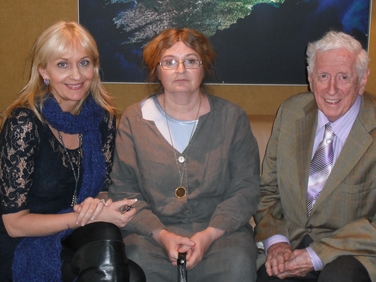 This week, Miriam O’Callaghan meets former Taoiseach Dr Garret FitzGerald and his daughter, Mary FitzGerald. Mary is his only daughter and mother to two of his ten grandchildren.
This week, Miriam O’Callaghan meets former Taoiseach Dr Garret FitzGerald and his daughter, Mary FitzGerald. Mary is his only daughter and mother to two of his ten grandchildren.
Together, they talk about their life sharing a home together today, their father/ daughter relationship, how Garret met Mary’s mother Joan and Garret’s career ![]() in politics.
in politics.
Mary explained the nature of their relationship: The main thing I would say is that my adolescence was one long argument. I remember thinking to myself when I was about fourteen that I was impressed that I could win an argument with him and he would change his views. And I remember thinking that I must remember to remain open in an argument to new ideas and remain open to another view point. Garret confirmed that these lively arguments continue to this day.
They have lived together for the past eleven years.
Garret explained : I am never lonely and that is important. I recently realised I was going to be in the house on my own for three days – it was an eerie experience. I had never been in a house on my own – I’d been with my parents, my wife, my children. I am very gregarious.
But Mary explained that her father is very fussy about his food: He will only eat food eaten by nineteenth century Irish peasants.
Garret explained to Miriam that his happiest time in politics was when he was Minister for Foreign Affairs. He also told her that his most difficult times were when he had to hurt people’s feelings like dropping Junior Ministers during Cabinet reshuffles.
Speaking about Charles Haughey, Garret Fitzgerald explained they never had any rows in private. And commenting on his “flawed pedigree” remark, Garret explained “that the speech was written at four thirty in the morning. It was a valid remark, but it was misinterpreted. Unlike all previous Taoisigh, he didn’t enjoy the full support of his party.” Mary commented “Pedigree is an obnoxious word”. Garret agreed “It wasn’t very bright.”
The recent controversial remarks by Leo Vradkar in Dail Eireann have left him unfazed. It was trivial, I was amused by it.
Mary is a visual artist. My paintings are all about pleasure, visual pleasure primarily.
A visit to the National Gallery with her father is recalled: I have very nice memories of going to the National Gallery with you for the first time when I was six and the paintings – the Lady Lavery with her children and all the purple.
She also painted a portrait of her father while they were on holidays in France about twenty years ago. Mary explained He said then if I was going to show it, I would have to put a shirt on him. Garret explained: So she put a shirt on me for the exhibition
Talking about his own parents, Garret explained that despite his mother’s disappointment that he was a boy, he enjoyed a close and loving relationship with them. Mary explained: They said ‘another bloody boy’ and his mother went off to Monte Carlo gambling for two months and wouldn’t come back.
Both Garret’s parents were involved in the events of the years from 1916 – 1923. What made this unusual was that his mother was a Northern Presbyterian. But Garret explained The Lynn sisters… and my mother were nationalists at Queens. I still have her cards for membership of the committee of An Cumann Gaelach…She was an Irish language enthusiast, a suffragette and a republican – tough on her poor father who worked running the distillery for the Craig family.”
My mother had been an extremist all along, my father was a poet and a clerk in London. She dragged him into politics and he ended up serving four terms in jail, she was never sent to jail which I always thought was unfair.
Commenting on her grandparents’ involvement in the 1916 Rising, Mary said:
I think you have to accept that there has been a huge change in values. People lived in a different world and they did things differently.
